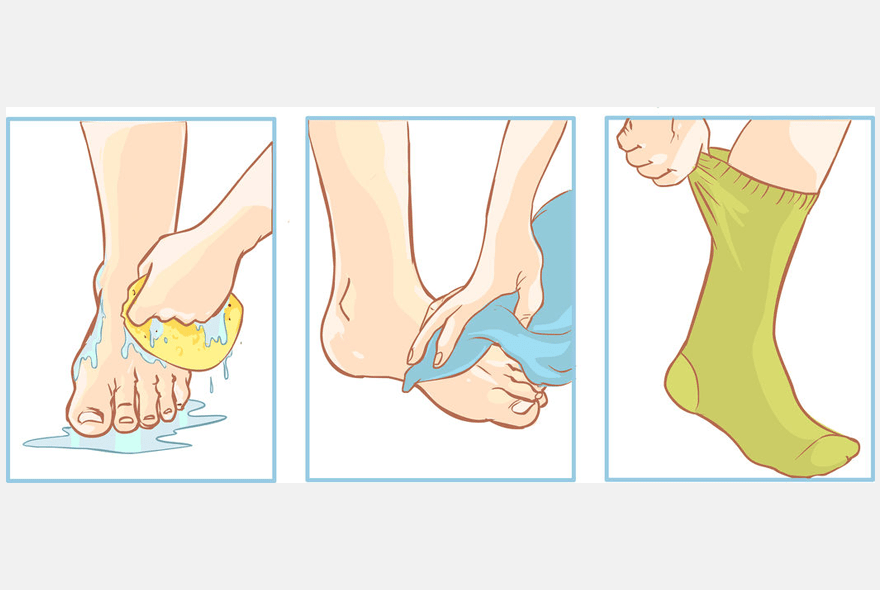
10 Foot Care Tips For Patients With Diabetes

There are many complications of diabetes. Uncontrolled diabetes damages small blood vessels which can adversely affect your eyes, heart, nerves, feet, and kidneys. Over here we discuss a few easy and simple foot care habits that you should add to your daily routine to protect your feet from diabetes-related complications.
Why foot care is important for patients suffering from Diabetes?
Your feet are at a higher risk of infections like calluses, corns, bunions, blisters, and ulcers. For a person with diabetes, a small cut on foot may become potentially disabling. Diabetes reduces blood flow to the feet, thus causing numbness in the feet. This may further prevent you from feeling the pain of small blisters or a foreign object in the shoe. There may be no pain at the initial stages, but it will gradually increase and spread to your legs. If left untreated for a very long time, it may even lead to amputation. A good foot care regimen can prevent pain and serious foot problems.
Foot care tips for patients with diabetes
- Inspect your feet regularly: Inspecting your feet for any cuts, blisters, swelling, redness, sores, and bruises should be part of your daily foot care regimen. If it is physically impossible for you to do so, then either use a mirror or seek someone’s help. If you find any change be it swelling or blisters, immediately contact your doctor.
- Wash your feet with lukewarm water: Never wash your feet in hot water as it will dry your skin making it more prone to cuts and cracks. Every day wash your feet in lukewarm water with mild antibacterial soap. A harsh soap may end up damaging your skin. Do not check the water temperature with your feet, as diabetes may make it difficult for you to sense the temperature with your feet. Use your fingers or elbow to check the water temperature.
- Keep feet dry: In a hurry to leave for work, you may forget to pat dry your feet. But people with diabetes must make sure to dry their feet before putting their shoes on. Moist areas are conducive for infections to develop especially between the toes. And, always wear socks that don't trap moisture.
- Moisturize your feet: As you age, the skin of the feet tends to get drier. Thus, you must after bath apply a small amount of hand lotion or petroleum jelly on the feet.
- Get an expert to cut your toenails: Diabetics should get an expert to cut their toenails. If mishandled, sharp clippers can cause injuries and any open cut or wound is susceptible to infection especially when it comes to diabetics. If a regular visit to health care experts is difficult, then get an adult family member to do the job.
- Use toenail clippers: Always use toenail clippers that are larger and have more leverage than fingernail clippers. When using fingernail clippers you might have to apply excess pressure that can lead to injury. Don’t use scissors or any other instruments to cut, tear your toenails or skin around your toenails.
- Diabetes-friendly footwear and socks: An investment in diabetes-friendly footwear and socks can go a long way in protecting your feet from infections. Though tight shoes or high heels now and then will not cause irreparable damage on a daily basis, one should wear comfortable and supportive shoes. For high-impact activities, go for sports shoes.
- Make sure your doctor examines your feet: Make sure your diabetes doctor examines your feet during every appointment. Make sure there’s an annual foot examination during which your doctor assesses sensation on your feet, inspects skin and check the temperature of your feet.
- Do not walk around barefoot: Diabetics must avoid walking around barefoot as it increases chances of injuries. At home, one should wear soft and comfortable slippers. Always ensure that the inside of your shoes are clean and do not have pebbles and sand.
- Quit smoking: Diabetics who smoke are at higher risk of developing complications. Studies seem to have shown that smoking is associated with diabetic foot amputation. Smoking in general put the health of your feet in jeopardy. Smoking not just harms lungs and heart, but it also affects proper blood circulation in your feet, causing your feet to develop sores and injuries.
Include Ayurveda in your Diabetes Management Plan:
According to Ayurvedic principles, a holistic approach towards health can help you live a healthier life. Include Ayurvedic principles in your daily routine - from eating and sleeping to exercising - to maintain a healthy and active lifestyle.
Explore our Ayurvedic products online
Our Ayurvedic product — Ilogen Excel — helps you manage the common symptoms associated with diabetes like numbness in hands & legs, fatigue, excess thirst, and frequent urination.
To know the details of the Ayurvedic product, visit https://pankajakasthuri.in/products/ilogen-excel-tablets














